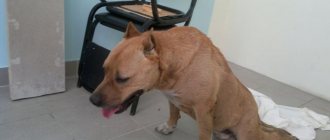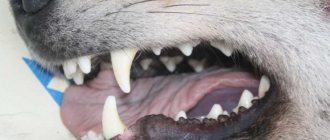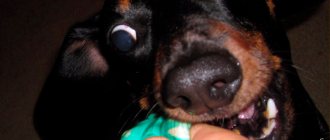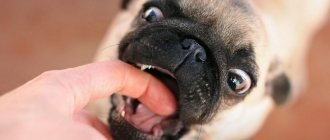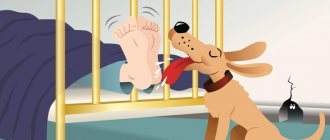Almost every owner dreams of his puppy and adult four-legged pet being healthy and happy. And noticing that the dear barking family member begins to drag his hind legs, walks unsteadily or trembles, the owner begins to panic and does not know what to do. You should not try to diagnose your dog yourself; it is best to seek help from a veterinarian.
Of course, it is best to find out in advance what can lead to impaired motor function in a dog. Yes, this knowledge cannot protect the animal, but it can help the owner notice in time that something is wrong with the pet. And if the puppy is sick, then timely treatment will help make the future life easier for the baby.
Answer
Old dogs get tired easily, sleep a lot, move little, rarely play and have difficulty hearing. An elderly pet does not please the owner with energy and enthusiasm. An old dog finds a secluded, cozy corner in which he can lie all day. The character becomes capricious and touchy, the dog is able to not respond to the owner’s call.
Unfortunately, pets age faster than their owners want. The onset of old age depends on the breed and size of the animal. Often dogs become old at 10 years old, but with proper care and care they live to be 20. Sometimes veterinarians advise euthanizing an old dog. The decision to euthanasia depends on the situation. You should help the animal live a long time and please its owners with your love.
When should you see a veterinarian?
Problems such as colds, viral gastroenteritis and even food poisoning are especially dangerous for puppies because they have weak immunity. Delay often ends in death. If a small family member refuses to eat or walks around lethargically, do not take risks and show him to the veterinarian.
Another reason to see a doctor is the duration of the hunger strike and apathy. It’s bad if the painful condition lasts longer than a week.
Also, the dog should be taken to the veterinarian if the following symptoms are detected:
- alternating constipation and diarrhea;
- blood in the stool;
- prolonged vomiting – more than 2 days;
- dullness and hair loss;
- dryness and yellowness of the skin;
- inflammatory process in the oral cavity;
- purulent discharge from the eyes;
- limb spasms;
- change in color of stool and urine;
- a sharp change in character.
In the situations described above, waiting and self-medication can cost you your health and even the life of your pet. Take pity on your four-legged friend and contact a veterinarian.
Why do my pet's back legs fail?
Old age is not always the only reason for a pet's paw failure. A number of neurological and orthopedic diseases have been described that lead to paralysis of the dog's hind limbs.
- In small breed dogs, the hind legs may fail due to frequent falls, for example, from jumping off sofas, benches, etc. Injuries occur in fights, when hitting cars, etc.
- If a pet lives in a city apartment and often climbs high stairs or falls on slippery surfaces, this can lead to paralysis of the limbs. Paralysis in the described case is caused by damage to the spine. At the time of injury, all components of the animal’s spinal column are affected. The developed edema puts pressure on the nerve trunks, and the animal loses the ability to move.
- Degenerative diseases of the spine, including those caused by aging pets. So-called local aging of individual areas of the spinal column may be observed. Spondylosis in quadrupeds has a low-symptomatic or asymptomatic course and is almost never diagnosed in the early stages of the development of the pathological process.
- Paralysis of the hind legs is caused by the development of tumor processes.
- A severe form of the disease is spinal osteochondrosis. All breeds are susceptible to the disease.
- Spinal discopathy is recognized as a common cause of paw failure in dogs. The disease is associated with colossal loads experienced by the quadruped's spine. Loss and protrusion of the intervertebral disc occurs during intense movement and at rest.
Content
1. How to determine that a dog’s paws are moving apart? 2. Discopathy 3. Mechanical injury 4. In this case it is necessary: 5. Diseases of the joints 6. How to treat? 7. Prevention
Sometimes, while walking down the street or in the park, you can meet owners with pets who have an “original” gait. The dog’s paws literally move out of the blue, and the owners perceive this as a funny aspect or a meaningless situation.
I would like to explain to such pet owners that this kind of animal behavior is not an attempt to make you laugh or just fool around, it is a sign of an illness, serious or not so serious, that needs to be sorted out. But under no circumstances should the situation be left as it is.
How to help an animal
The ideal solution would be to find a really kind and caring veterinarian who will not dismiss it and send your pet to be euthanized, but will recommend appropriate treatment.
Try to partially restore your pet's strength and performance with the help of medications. Carry out a course of treatment with injections of the drug Milgamma. The drug includes a complex of B vitamins, which improves nerve conduction and is effective for all kinds of polyneuropathies. The drug is administered 1 ml once a day for 7 days.
The drug Cerebrolysin, which is injected subcutaneously into the dog for 10 days twice a day, has a good effect. For oral administration, give the dog Traumatin and Chondartron for 1-2 weeks.
Veterinarians recommend giving an elderly pet the drug Gamavit intravenously for 2 days, then continuing to inject 10 ml into the withers for an additional week. The drug is painful, the animal may whine or snap. However, it is effective even for elderly pets.
Within 5 days, inject the four-legged animal under the skin of the withers with 5 ml of emicidin.
If a positive effect is noted, it is possible to continue Gamavit injections for up to 10 days.
If it is impossible to administer drugs intravenously, inject under the skin on the withers and back.
Causes
Food intake is influenced by the quality of food and feed, health status, mood and even relationships with family members. If your pet refuses to eat or drink water during the day, do not rush to panic. But prolonged refusal to eat and the appearance of other symptoms (vomiting, diarrhea, cramps) are a reason for concern.
What are the causes of hunger strike and lethargy
Below are common reasons why your dog may appear lethargic and not eat.
Stress
A dog is the same emotional and vulnerable creature as a person. He gets upset because of loud scandals, criticism, and the departure of his beloved owner. By refusing food, he protests against moving to a new apartment or the appearance of strange animals. Some pets react sharply even to changes in weather and season, and easily fall into the autumn blues. As a rule, a hunger strike due to stress lasts for a maximum of 2-3 days.
Poor nutrition
The pet refuses to eat tasteless or low-quality food, monotonous food, or drink stale water. Perhaps at one time she was accidentally given a spoiled product, which led to vomiting and diarrhea. Now the dog is wary of him and doesn’t want to risk his health.
A common mistake people make is that they spoil their pets too much. For example, they put dry food in a bowl, but the four-legged friend does not finish the granules. Then the owners, wanting to please him, add something tasty: a piece of fish, sausage, beef tenderloin.
The animal quickly gets used to this privileged regime. Why chew dry food or porridge with liver if a person offers something tasty an hour later? The lethargy of the pet is a consequence of voluntary starvation.
Another reason associated with poor nutrition is overfeeding. Because of this, an excess of fluid and nutrients is formed in the animal’s body: proteins, fats or carbohydrates. The pet feels that it is oversaturated and refuses food itself. Please note that an adult dog can fast for 5-7 days without harm to health (but still drinks water).
Dental problems
Due to physical pain when food and liquid come into contact with the oral cavity, the dog does not eat, does not drink, and looks lethargic. The following problems cause a hunger strike:
- teething in small puppies;
- tartar, which provokes inflammatory processes: periodontitis, growths, abscesses;
- broken tooth;
- gingivitis - damage to the soft tissue of the gums;
- stomatitis – inflammation of the oral mucosa;
- mechanical damage in the mouth and tongue (sores, ulcers);
- dislocation of the jaw.
Periodically, the animal approaches food and water. Perhaps he is trying to eat or drink, but is behaving strangely (for example, shaking his head sharply, swallowing liquid with his jaws rather than with his tongue).
Cold
Not only people, but also pets are susceptible to this disease. Puppies and old dogs are at risk because they have weak immunity. During a cold, the animal is bothered by muscle weakness, so it looks lethargic and is lazy to approach a bowl of water or food.
Also, appetite decreases due to fever. The body puts all its energy into fighting the virus, so it has difficulty digesting food.
Poisoning
You yourself know that after poisoning you don’t want to eat for 1-2 days, you don’t have the strength to move, your mood is sluggish. The same thing happens with a pet. Poisoning is caused not only by spoiled foods. The list is much wider:
- dirty or bacteria-contaminated water;
- household chemicals (solvents, chlorine-containing bleaches and paint are especially dangerous);
- insecticides: shampoos and drops against fleas, worms;
- cheap dry food with allergen additives;
- medications;
- mercury;
- some indoor plants: azaleas, rhododendrons, daffodils, garden palms, tulips;
- AA batteries (contain lead, which is toxic to pets);
- fertilizers for plants;
- pesticides;
- human food: chocolate, alcoholic beverages, grapes, avocado, xylitol.
Now remember if your pet has had contact with any of the above. If the lack of appetite and lethargy are accompanied by vomiting, diarrhea, dry skin, yellowing of the whites of the eyes, urgently take your pet to the veterinarian.
Worms
A common reason why a dog is lethargic and does not eat. Parasitic worms reduce the lumen of the intestines, interfering with the passage of food. Therefore, the pet refuses to eat due to pain and a feeling of fullness. Worms attach to the walls of the colon, blocking receptors that transmit hunger signals to the brain. Parasites also release waste products - toxins, which lead to lethargy.
Serious illness
If the pet does not eat, does not drink, or has been lethargic for a long period (more than 2 weeks), there is a possibility that it has a serious illness.
- Viral gastroenteritis Old dogs and puppies are most often affected. The following symptoms are observed: refusal to take food, water, nausea, loose stools, indifference to others. Vomiting does not always happen. The disease is curable if you do not hesitate to go to the veterinarian.
- Intussusception Appetite drops sharply due to intestinal obstruction. The disease is caused by blockage of the gastrointestinal tract with foreign objects (cellophane, paper, bones, hair), vascular pathologies, gastric volvulus and strangulated hernia. Intussusception requires surgery. Untimely detection of pathology can lead to death.
- Liver failure Occurs due to damage to the organ by toxins and viruses. The owner should be alert to the following symptoms: refusal of food and water, lethargy, dull coat, yellow skin, vomiting, alternating constipation and diarrhea, white feces and bright orange urine, limb cramps. Treatment prolongs the life of the pet.
Sometimes stomach ulcers, metabolic disorders and cancerous tumors (intestines, kidneys, bladder) lead to a decrease in appetite.
When is refusal of water and food the norm?
The reasons listed above are caused by various problems and require the intervention of the owner. But there are cases when a dog’s refusal of food and water is the norm, and there is no need to worry.
- Lack of movement or excessive exercise. If your pet rarely goes outside and plays little, her body does not have time to burn all the calories. Therefore, she regularly arranges fasting days for herself. What then does excessive physical activity have to do with it (hunting, running, performing tricks)? They lead to an increase in blood glucose, which dulls hunger for 3-6 hours.
- Advanced age. After 12-15 years, the dog’s metabolism slows down, which leads to a decrease in appetite. And lethargy is a consequence of old age.
- Estrus period, pregnancy, postpartum period. Decreased appetite and changes in eating habits are caused by hormonal imbalance.
In such situations, you do not need to do anything. The animal itself will regulate the required amount of food without harm to the body.
What tests will help determine the disease?
If you suspect your animal has a disease, contact your veterinarian. The doctor will prescribe special tests and examinations that will help understand why the dog is lethargic and does not eat or drink.
Table 1. Diagnosis of diseases
| Method | What diseases does it help detect? |
| Visual examination by a veterinarian | Dental problems, injuries, gastrointestinal diseases. The examination makes it clear which diagnostic methods to use next. |
| Temperature measurement | Viral infections, poisoning |
| Stool analysis | Worms, liver failure |
| Analysis of urine | Diseases of the kidneys and gastrointestinal tract |
| Blood chemistry | Colds, viral gastroenteritis, poisoning |
| Abdominal ultrasound | Intussusception, diseases of the digestive system, liver failure, |
| X-ray | Trauma, cancer |
Sometimes an examination and 1-2 tests (blood, urine) are enough. But if you suspect a serious illness, you will have to undergo a comprehensive examination at the clinic.
Caring for an old dog
Be sure to regularly take your elderly pet to the veterinarian. Do not wait until the emerging disease enters the phase of irreversible changes. Brush your dog's teeth regularly with a special toothpaste for animals. Diseases of the gums and teeth are the scourge of older dogs.
Old animals need frequent bathing and regular brushing. When brushing your pet, feel the skin to detect growths or tumors in time. Check your dog's eyes and ears regularly.
Do not change the long-established way of life of your pet - this causes stress in an elderly animal, which will lead to illness and a shortened life. Let the dog live in its usual place, eat its usual food. An elderly dog needs increased attention and affection from its owners. Physical activity should be feasible for the animal and not cause severe fatigue and severe shortness of breath.
Symptoms
Usually, owners quickly notice that the animal is not in order. If there was an injury, then the dog most often simply stops getting up on its paws immediately or the next day.
If the disease develops gradually, symptoms may more often manifest themselves in behavior:
- The dog is reluctant or takes a long time to get up after sleep
- A previously active and playful dog ceases to be interested in walks, favorite toys, and outdoor games.
- Change in gait: the dog drags its paws, walks more slowly, or its gait loses its natural harmony and grace
- Sometimes the dog may yelp or whine. This happens when stroking, leaning on a sore paw, or walking.
- The dog is slouching, hunching over
- In severe cases, involuntary urination may additionally occur.
Diagnosis and treatment
It is worth mentioning the diagnostic process, but first you should understand that it is not possible to identify the problem yourself, and it is prohibited to do so, because the situation may worsen. If you suspect ataxia, you should contact your veterinarian immediately. An interesting fact is that no test or diagnostic method has yet been invented that would determine the presence of ataxia of any type.
The veterinarian makes a diagnosis after a full examination and questioning of the owners, and sometimes it is necessary to do a whole range of different tests:
- Analysis of urine;
- blood analysis.
Sometimes it is useful to do an MRI, but not everywhere there is such an opportunity, and such a procedure will be very expensive. For this reason, specialists most often limit themselves to X-rays. Other tests are also prescribed, but they all depend on the results of the examination.
As you might guess, the treatment process will completely depend on the cause of the disease. If a dangerous infectious disease is detected, the dog will be given strong antibiotics. If the problem is a tumor, then veterinarians will perform surgery.
As for more complex situations, for example, when ataxia is caused by a hereditary defect, it is not possible to cure it. For this reason, specialists can only prescribe supportive treatment to maintain a normal standard of living for the pet. Such therapy includes sedatives that can relieve panic.
As for the treatment of various movement disorders, only specific medications can be used for this purpose. It is strictly forbidden to self-medicate an animal, because serious drugs will only make it worse if given incorrectly.
Important! If your animal's ataxia is of the cerebellar type, then you must adapt the apartment to his life. The dog should be given a room where there are no sharp corners or objects, because over time his condition will deteriorate greatly even if he takes the necessary medications prescribed by the veterinarian.
Currently reading:
- Identifying the Symptoms and Treatments for Dog Ataxia
- Thyroid dysfunction in dogs (hypothyroidism)
- Pinched nerves and subtle symptoms in dogs
- Symptoms and actions for abdominal cramps in a dog
Tumor formations
The cause of pain and limitations in mobility is not always diseases and pathologies of the musculoskeletal system and joints. Equally common are tumor formations that affect bone tissue.
Such formations include bone cancer. Obvious symptoms of cancer are detected already in the later stages: the dog experiences difficulty moving, going up and down stairs, accompanied by pain.
What breeds are at risk?
Some breeds are more likely to lose their paws than others. This is explained by strict selection, forced changes in the skeleton for the sake of working or decorative qualities.
Typically, leg failure occurs in young and adult pets between 3 and 8 years of age, and less commonly in puppies.
Arthrosis or spondylosis makes itself felt in older dogs - at 11 - 14 years old and older.
The following are susceptible to paralysis:
- dogs with a long body - dachshunds, basset hounds;
- brachycephalics - pugs, bulldogs (English and French), Pekingese, Brabançons, boxers, sharpeis;
- large breeds - St. Bernards, Great Danes, Shepherds, Labradors, Alabais.
